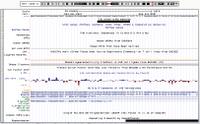In this page we offer several options to download or view the novel miRNAs presented in [1]. If you use these novel miRNAs please cite this paper.
Novel microRNAs (miRNAs)
MicroRNAs (miRNAs), small RNAs that are around 22nt in length. They are important regulators of posttranscriptional gene expression. miRNAs are shown to participate in many cellular processes, and depend on organism, disease, and tissue. Nearly 2,800 human miRNAs were annotated in public repositories in 2015. However, it is unknown how many miRNAs are harbored by the human genome and animal genomes.
We report findings from analyzing 1,323 short RNA-seq samples from 13 different human tissue types. Using stringent thresholds, we identified 3,707 statistically significant novel mature miRNAs, from 3,494 novel precursors. Of these novel miRNAs 91.5% were identified independently in 10 or more of the processed samples.
Analysis of these novel miRNAs revealed tissue-specific dependencies (low Jaccard similarity index in intertissue comparisons). Of these novel miRNAs, 1,657 (45%) were identified in 43 datasets and represented 3 of the 13 tissues. They were generated by cross-linking, followed by Argonaute immunoprecipitation and sequencing (Ago CLIP-seq). This indicates that these miRNAs are active in the RNA interference pathway. Experimental investigation through stem-loop PCR of a random collection of newly discovered miRNAs in 12 cell lines representing 5 tissues confirmed their presence and tissue dependence.
Among the newly identified miRNAs are:
- many novel miRNA clusters
- new members of known miRNA clusters
- previously unreported products from uncharacterized arms of miRNA precursors and,
- previously unrecognized paralogues of functionally important miRNA families (e.g., miR-15/107)
Examination of the sequence conservation across vertebrate and invertebrate organisms showed 56.7% of the newly discovered miRNAs to be human-specific whereas the majority (94.4%) are primate lineage-specific.
Our findings suggest that the repertoire of human miRNAs is far more extensive than currently represented by public repositories and that there is a significant number of lineage- and/or tissue-specific miRNAs that are uncharacterized.
Access
novel microRNAs on the UCSC genome browser track
Download novel microRNAs
Click the button below to browse and download compressed files containing: a) an image of the predicted miRNA precursor’s 2ndary structure in PDF format, and, b) a list of mRNA targets predicted by RNA22 (v2) in plain text.
Click on the buttons below to download a file of all mature coordinates in BED format (GRCh37), or the mature and precursor sequences and coordinates in MS Excel (GRCh37).
References
- Londin, E, Loher, P, Telonis, AG, Quann, K, Clark, P, Jing, Y, Hatzimichael, E, Kirino, Y, Honda, S, Lally, M, Ramratnam, B, Comstock, CE, Knudsen, KE, Gomella, L, Spaeth, GL, Hark, L, Katz, LJ, Witkiewicz, A, Rostami, A, Jimenez, SA, Hollingsworth, MA, Yeh, JJ, Shaw, CA, McKenzie, SE, Bray, P, Nelson, PT, Zupo, S, Van Roosbroeck, K, Keating, MJ, Calin, GA, Yeo, C, Jimbo, M, Cozzitorto, J, Brody, JR, Delgrosso, K, Mattick, JS, Fortina, P, Rigoutsos, I. Analysis of 13 cell types reveals evidence for the expression of numerous novel primate- and tissue-specific microRNAs. Proc Natl Acad Sci U S A. 2015;112 (10):E1106-15. doi: 10.1073/pnas.1420955112. PubMed PMID:25713380 PubMed Central PMC4364231.

